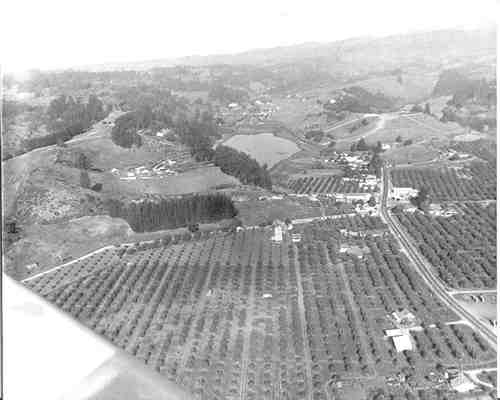
On Sunday, October 15, 1769, the Portola expedition's route took
them northwestward across the (Corralitos) creek and through a redwood
forest. They stopped to camp near a lagoon in the middle of a narrow
valley. Father Crespi named this campsite Santa Teresa. They left
this place in the morning by a northwest course, following the narrow
valley where there were many extremely large redwood trees.
The lagoon was named Laguna de las Calabasas. It derived its name
from calabash, or water gourd that grew in that area at the time.
Calabasas Lagoon has been referred to as Corralitos Lagoon on some
maps over the years. The lagoon is located on the Corralitos Rancho
property very near its boundary with the Calabasas Rancho. As are
so many other locales or landmarks, it is referred to by different
names depending on who is referring to it. Today it is most often
called Chandler Lake or Freedom Lake. The lagoon itself covered a
larger area in the earlier years. The southeastern end reached nearer
to the Five Mile House.
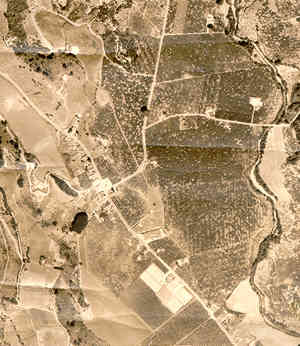
Jose Amesti was granted the Corralitos Rancho land in 1827. In a
few years, he began leasing portions of his property for timber cutting,
as well as having his own whipsaw lumber mill on the upper portion
of the rancho. The redwoods grew down through the Corralitos valley,
including the Five Mile House area, as well as in the canyons.
Charles Ford was one of the earliest purchasers of property from
Don Amesti. He bought 67 acres westerly of the Corralitos Creek. This
included property that would later be known as the Five Mile House
section. He paid $335 in gold coin.
In 1852, Asa P. Sanford purchased a portion of the Calabasas Rancho
from D. Hernandez. 3 January 1862 in consideration of $1200, Asa P.
Sanford purchased an interest in the Ford property on the Amesti rancho.
Sanford was involved in the ownership of property in Corralitos, as
well. Some early maps show Corralitos Road as being "the road to Sandy's
camp". Does anyone have information about Sandy's Camp? Sanford
operated a stage stop for a number of years at what today is known
as the Five Mile House area. The exact location of his stage stop
has not been determined in this article. He died in 1874, but the
area at the intersection of today's Corralitos Road and Freedom Boulevard
remained Sanford's Corner, Sandy's Corner, or the Corners until sometime
after 1890.
In a newspaper article in June 1875, Henry Martin's new hall at Sanford's
Corner is noted: "Henry Martin, of nearby Sanford's Corner, had his
new hall christened by a Grand Ball with Johnson and Sullivan of this
place as musicians. Elegantly dressed ladies and fine looking gentlemen
attended." In 1876, the Corners Harvest Ball, with the same musicians,
had seventy couples attending. Another article refers to Martin as
the popular landlord of The Five Mile House. Henry Martin's wife was
named Katherine.

Was Martin's Five Mile House once Sanford's stage stop or was
Sanford's on the property on the Corralitos side of the Santa Cruz
Road nearer the higher land away from the lagoon?
February 1881: "All who desire a regular, old-fashioned good time,
should not fail to attend the Cox Boys' dance at the Corners on Tuesday
evening. A splendid time is guaranteed all who attend. Tickets to
the ball and lunch, $1.00."
In 1883/84, McKenney's Pacific Coast Directory listed Henry Marten's
(sic) hotel, saloon, and feed stable under the heading Five-Mile House.
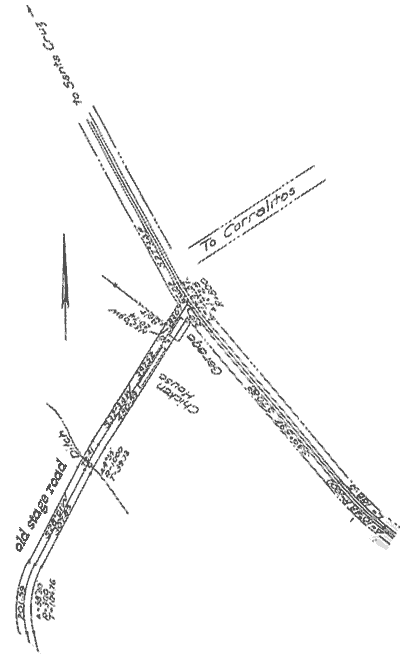
The lane that today runs alongside Hansen's Feed is referred to as
the stagecoach road or lane on early maps. This would have run alongside
Martin's Five Mile House.

Bob and Loretta Bridgette playing on old stage road on Bridgette
property.
Coast Commercial Record of 1890: "About two miles southwesterly from
Corralitos on the county road leading to Santa Cruz is the nucleus
of a village known as Sanford's Corner at present. It is a halting
and watering place for the numerous teams that haul lumber from the
mountains, straw to the paper mill, and for stages. Here there are
two saloons, one lodging house, one hall for public meetings, a blacksmith
shop, and several dwellings."
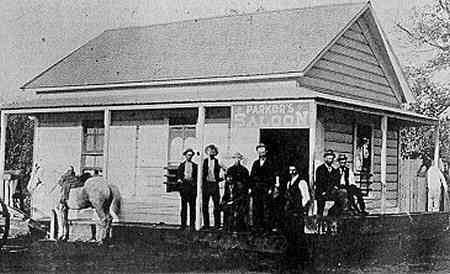
Parker's Saloon, one of the saloons at the Five Mile House Section.
Bose(s) Parker standing in front in shirt sleeves.
The intersection of the Mt. Madonna Cross Road (present day Varni
Road) and the road to Corralitos is just northeast of the Five Mile
House. The Cross Road was once a scenic short cut for all traffic
from Gilroy or the Santa Clara Valley to Santa Cruz.
Charles Moss owned acreage on both sides of the Santa Cruz-Watsonville
Road, north of Sanford's property. There was a large orchard on the
Moss property. People went there every summer to buy fruit to can.
Mrs. Moss sold the fruit at the orchard gate during the fruit season.
Moss Landing was named for Charles Moss. He and a partner, Beadle,
after starting a line of schooners at the landing in 1865, constructed
a wharf to facilitate the loading of freight. After that, Moss moved
his family from the ranch near the Five Mile House to a house near
the landing.
Samuel Mann started his apple business that continues today, when
he purchased the Portius F. Dean ranch and settled his family near
Corralitos in the 1870s. This property was on the south side of Sanford's
property, as can be seen above on the Martin Five Mile House map.
The Mann house is located on the corner of Corralitos Road and Freedom
Boulevard. The back portion of the house was constructed in 1890 and
the front part in 1920. The packing shed on Freedom Boulevard, just
beyond the house, was built in 1932. Their apple business, Elwin R.
Mann, Inc., is named after a grandson of Samuel Mann. A newspaper
item from 2 February 1889 stated: "In the vicinity of Corralitos there
has been a very considerable increase in orchard acreage this season.
Along the county road from the Corners to here is almost continuous
line of orchards, and they are all thrifty."
54 Corralitos Road was once the residence of Robert Mann. In the
early 1900s, he had deer living within a fenced area in his yard.
In more recent times, Corralitos Road was altered in front of the
residence. Remains of the old road are still evident.

Robert Mann with deer
About 1919, Niels Peter Jensen started Alladin Nursery. He was born in Denmark on October 17, 1888. He spent his early years in the Bording-Silkeborg areas of Denmark. He graduated from the University of Copenhagen with a degree in Horticulture. He came to the United States in 1911 and worked until 1913 in the Connecticut and Pennsylvania areas. In 1913, he came to California and worked as an estate caretaker for the lumber tycoon, J. Tyson of Piedmont. In Piedmont in 1917, he married Maria Rasmussen of Horsens and Copenhagen. The Jensens had two daughters, Helen and Edith.
Peter and Maria purchased property including where the nursery is today from Mr. and Mrs. Schroeder. This property also included the following: “The area directly across from the Corralitos road and back to the Schmidt property line. The old yellow home which was on this property was there when it was purchased from Schroeders. A small grocery store and service station was built by the Jensens on the corner next to the yellow house at a later date. The area comprising the current Alladin parking lot back to Chandler's Ditch, with the road between the nursery and the parking lot known as Chandler's Road. The then orchard and grape area back to the top of the hill at the rear of the nursery as well as the then orchard area on the sloping hillside to the right of Chandler's Ditch off Chandler's Road."
Peter named the nursery “Alladin” because it was his early dream to have his own nursery business. When he was able to do this, he felt the genie had made his dream come true. He worked in the Watsonville area for the H.A. Hyde Company until 1925 when the Alladin Nursery was started on its present site.
The building that stands today on the corner of the original Five Mile House property is the one built by the Jensens. They rented it to Orville "Shorty" Johnson who lived there and ran a small grocery and gas pumps in part of the 40s and 50s. The Jensens lived in the house next door, alongside their nursery . Mr. Jensen passed away on November 28, 1958.
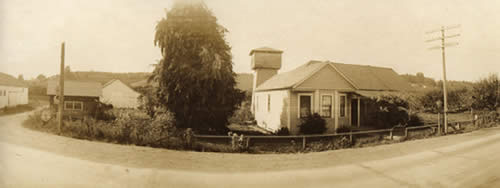
1920 Jensen residence
(Across from the intersection of Corralitos Road with Hansen Feed building on left. Tree is still there)
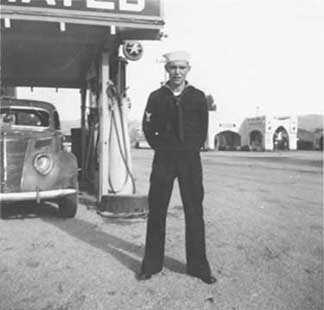
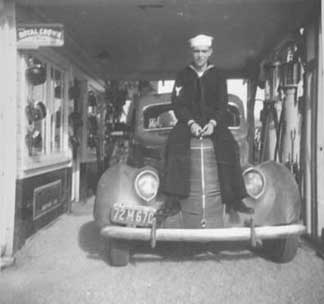
c1944 Ray Pybrum at Orville's grocery
Alladin Nursery was bought in 1946 by Ben and Dorothy Roth. They continued with the retail nursery and grew bedding plants for the Coastal Retail Nursery trade. The nursery was taken over by Eldon and Les Roth, their two sons, in 1970. They presently run the family business with their wives Susan and Joyce. The nursery has gone through fire in 1969, floods in 1982, drought in the 1980's and earthquake in 1989. The nursery has grown from a small wholesale bedding plant business into a retail nursery, florist, and landscape contracting business. (Nursery information provided by Les Roth.)
A newspaper article from 2 March 1929 stated, "A.W. Story, the well-known local architect, has designed a unique service station of the modified old Spanish type, for Frank J. Scott, the Corralitos merchant. The new station will be situated on the site of the Kern's property that was recently cleared at the Five Mile House for that purpose. Work has already been started by Harold Graham, the local contractor, and will be rushed to completion. The architecture and finish on the building will be different from anything ever before attempted in the service station building line. When completed, it will be a credit to the owner and a welcome addition to the Five Mile House section." Mary Kern owned the property including Kern's pond/lake (Merk today) that once was owned by Sanford. Mr. Scott called his service station 5 Mile House.
For many years, there was a steel button in the center of Corralitos Road where it intersects with Freedom Boulevard. This marked the five-mile point from Watsonville. Local kids use to play baseball there and use the button for home plate.
The Hansen Feed building located on the Bridgette property was an automobile garage for some years. Inside, a pit was dug in the ground where the cars were parked for oil changes and lubes, etc.
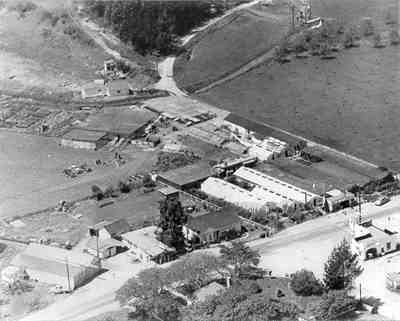
Five Mile House Section circa 1950.
Mr. Ernest Chandler and his wife Carrie moved here with their four
children on March 20, 1920. They purchased property that included
the Calabasas Lagoon along with a house that had been built in 1890.
Don, their second son, remembers there were very few buildings here
then. He remembers as a child going into a store that was located
approximately where the long building behind the present day Five
Mile House Coffee Shop is located. He remembers it as being an elevated
building, maybe three feet off the ground facing Corralitos Road.
Across Corralitos Road from the store were two stands of redwood trees
on the Mann property. Near one stand there was a corral where cattle
were kept on drives from Hollister. The Chandler children walked to
the Calabasas School by way of the old stage road. Don remembers going
into the store to buy punches on a punchboard to win prizes like candy,
toys, or small items. Punchboards were popular with adults too. The
grand prize might be a shotgun or a 22 rifle. The Chandlers farmed
in the lagoon until the 1960s. Every year they drained the water in
the spring. They had found that a redwood flume had been constructed
sometime in the 1800s to drain the lagoon when it reached a certain
level. The 18" wide redwood flume ran for about a ˝ mile south to
eventually flow into Corralitos Creek. The flume began near the middle
of the lake. It was buried about two feet and was airtight due to
the crisscross construction of the 2" thick redwood planks with 4
to 5 foot planks. When the water pressure in the lake became heavy
enough it would begin to flow through the flume. The Chandlers used
this system until it began to rot in areas and cause problems. They
installed a pump at the southern end of the lagoon and pumped the
lagoon every spring. In the upper right corner of the aerial photo
of the Five Mile section, the pump can be seen with water flowing
out of it. The Chandlers sold Chandler Lake to Santa Cruz County in
1965. Information courtesy of Don Chandler

Five Mile House Section viewed from Chandler residence 1944.
In 1941, Clyde and Nell Sanders purchased the corner property. At
that time, the Five Mile House service station, restrooms, the house
(Cadillac Café), and an old tin-roofed building were on the property.
The old building was in the location that Mr. Chandler remembered
as being a store. Mr. and Mrs. Sanders operated the service station.
A large scale was at the rear of the building. Apple farmers came
through to weigh their loaded trucks on their way to market. Eventually,
the Sanders added a bar inside that became a popular hangout for locals
as well as passersby on the old Watsonville-Santa Cruz Road. Mr. Sanders
built the building that still stands next to the Cadillac Café. In
front was a restaurant-bar and in the rear was a shop. Gilmore Gas
was the brand name of gasoline that was sold at the time. Gilmore's
trademark was an African lion leaping/jumping through a burning hoop.
Mr. Sanders painted his pickup yellow and had the reddish colored
lion logo on each door.
Most memorable of their time as owners of this property were the
lions. Not the Gilmore lions but live African lions. One day, the
Barnum & Bailey Circus came to Freedom and set up in a big open field
that was near present day Freedom Boulevard between the Shell gas
station and Kmart. The Sanders' young son, Mickey, was excited about
the circus, especially because of the lions. He wanted to see the
lions. Everyday he begged and begged his mother to take him to the
circus. They went to the circus, but as it turned out, there were
no lions. Mickey was greatly disappointed. A day or so later, a large
1941 Chevrolet truck roared up to the Sanders service station. It
was piled two or three layers high with cages. Inside the cages were
lions. The owner of the lions, who was the circus lion tamer, came
inside and explained to Mr. Sanders what had happened. The lions were
supposed to have been at the circus, but the tamer had a run-in with
someone there and had been beaten with a cane. He was out of money,
so he asked Mr. Sanders for a loan. He gave Mr. Sanders two lion cubs
to keep until he could repay the money. Mr. Sanders agreed and became
the owner of the two cubs, Leo and Juney.
Mr. Sanders built a cage from cyclone fencing along side the restrooms
at the rear of the service station. This became the home for Leo and
Juney. The lions became family pets. The lion tamer did return after
the lions were grown. He didn't want them back even if Mr. Sanders
would have been willing to part with them, which he was not. The tamer
said they were too old for training by then.
There were a lot of lion stories for that period of time. Sometimes
to clear out the bar when the patrons were not willing to go home,
Mr. Sanders would bring in one of the lions. That did it. For the
family they were harmless pets. For anyone else, they were African
lions!
On more than a few occasions Mr. Sanders would sometimes 'forget'
to lock the cage door. The lions would go for walks, but not far.
Sheriff deputies would come by and call to Mr. Sanders with a bullhorn
to tell him his lions were out. They would not get out of their patrol
car because they were afraid. Once they did, and walked up and found
one of the lions. They said they were ready to shoot, but they were
afraid to do that, too. They went back to their car and continued
to call for Mr. Sanders.
The Sanders also had a pet spider monkey named Duke. Duke's leash
was attached to a cable so he could run back and forth between the
lion cage and the house.
Mr. Sanders passed away in 1946. Mrs. Sanders continued to run the
service station. She gave the two lions to the San Francisco Zoo.
She was remarried to Tony Brautovic. It was Tony who built the four-unit
motel behind the service station about 1950. They sold the property
in 1955. Information courtesy of Mickey Sanders
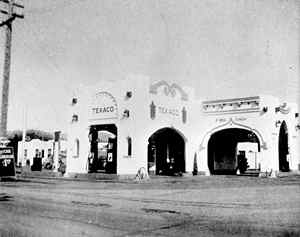 Scott
Park is located northeast of Chandler/Freedom lake. Bert Scott donated
this land to the County of Santa Cruz. On the opposite side of Freedom
Boulevard is the Bert Scott Estate, a 31.5-acre parcel classified
as a local rural park. It was once part of the Charles Moss property.
This facility is not yet open to the public. It is anticipated that
the estate will be open to the public in the future, however, major
improvements to the entry road will need to be made to accommodate
emergency service vehicles. The property features a large residence
with caretaker's cottage and an established garden. One of Mr. Scott's
wishes was to have an historical library in the residence. This facility
has the potential to be very beneficial to the local community.
Scott
Park is located northeast of Chandler/Freedom lake. Bert Scott donated
this land to the County of Santa Cruz. On the opposite side of Freedom
Boulevard is the Bert Scott Estate, a 31.5-acre parcel classified
as a local rural park. It was once part of the Charles Moss property.
This facility is not yet open to the public. It is anticipated that
the estate will be open to the public in the future, however, major
improvements to the entry road will need to be made to accommodate
emergency service vehicles. The property features a large residence
with caretaker's cottage and an established garden. One of Mr. Scott's
wishes was to have an historical library in the residence. This facility
has the potential to be very beneficial to the local community.
The Five Mile House area is a special place with a history of its
own. It would be good to be able to preserve its identity and historical
heritage.
